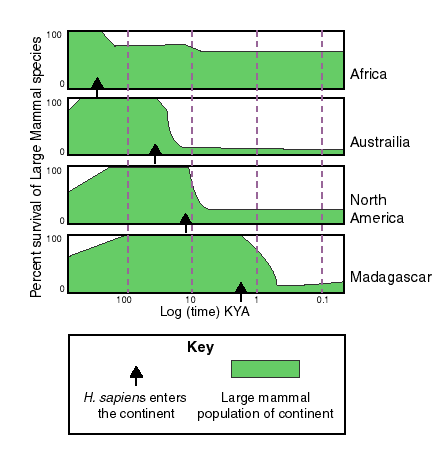
Paul S. Martin
Encyclopedia

University of Arizona
The University of Arizona is a land-grant and space-grant public institution of higher education and research located in Tucson, Arizona, United States. The University of Arizona was the first university in the state of Arizona, founded in 1885...
who developed the theory that the Pleistocene extinction
Quaternary extinction event
The Quaternary period saw the extinctions of numerous predominantly larger, especially megafaunal, species, many of which occurred during the transition from the Pleistocene to the Holocene epoch. However, the extinction wave did not stop at the end of the Pleistocene, but continued especially on...
of large mammals worldwide was caused by overhunting by humans. Martin's work bridged the fields of ecology, anthropology, geosciences and paleontology.
In 1953 Martin received his bachelor's degree in zoology
Zoology
Zoology |zoölogy]]), is the branch of biology that relates to the animal kingdom, including the structure, embryology, evolution, classification, habits, and distribution of all animals, both living and extinct...
from Cornell University
Cornell University
Cornell University is an Ivy League university located in Ithaca, New York, United States. It is a private land-grant university, receiving annual funding from the State of New York for certain educational missions...
. In 1953 and 1956 he completed his master's and doctorate programs at the University of Michigan
University of Michigan
The University of Michigan is a public research university located in Ann Arbor, Michigan in the United States. It is the state's oldest university and the flagship campus of the University of Michigan...
and then proceeded with postdoctoral research at the Yale University
Yale University
Yale University is a private, Ivy League university located in New Haven, Connecticut, United States. Founded in 1701 in the Colony of Connecticut, the university is the third-oldest institution of higher education in the United States...
and the University of Montreal. He joined the faculty of the University of Arizona
University of Arizona
The University of Arizona is a land-grant and space-grant public institution of higher education and research located in Tucson, Arizona, United States. The University of Arizona was the first university in the state of Arizona, founded in 1885...
in 1957 and worked there until his retirement in 1989. A case of polio, contracted while doing undergraduate field work in Mexico, forced Martin to rely on a cane, which restricted but did not end his field work.
Overkill Hypothesis
Martin developed the theory known as “overkill” or the “blitzkrieg model” based on his early insight that the sudden demise of large Ice Age mammal populations on different continents and at different times coincided with the arrival of humans. He believed that as they migrated from Africa and Eurasia to Australia, the Americas, and the islands of the Pacific, humans rapidly hunted the large animals endemic to each continent to extinction. Martin particularly focused his research on North America, whose late Ice Age fauna rivaled that of Africa today.There, he theorized, around 11,000 years ago, newly arriving humans hunted North America's Ice Age big game, including ground sloths, camels, mammoths and mastodons, to extinction. The theory, summarized in Twilight of the Mammoths: Ice Age Extinctions and the Rewilding of America (2005) has been widely discussed and remained controversial. Critic Michael Fosha wrote that although Martin attempted to discuss and debunk alternative explanations of the extinction, he did not adequately examine mainstream theories like changes in climate and vegetation. According to Fosha, Martin presented a vivid account of prehistoric people's assault on nature "with the efficiency of a German panzer division
Panzer Division
A panzer division was an armored division in the army and air force branches of the Wehrmacht as well as the Waffen-SS of Nazi Germany during World War II....
" but Fosha felt that his views on archaeology were inaccurate. However, Fosha wrote that the book presents "excellent data on the Southwest" and deserves serious attention for it.
Martin sometimes faced criticism from archaeologists and paleontologists who claimed earlier dates for human arrival in the Americas or later dates for certain extinct animals than the overkill theory would suggest. Martin maintained that such claims were the result of faulty scientific analysis and pointed out that no such dates had yet been independently verified.
Rewilding
Martin also championed the concept of “rewilding”Pleistocene Rewilding
Pleistocene Rewilding promotes the reintroduction of descendants of Pleistocene megafauna, or their close ecological equivalents. An extension of the conservation practice of rewilding, which involves reintroducing species to areas where they became extinct in recent history , Pleistocene rewilding...
, or “resurrection ecology” in which extinct N. American Pleistocene fauna could be restored by establishing breeding populations of surviving animals from other continents (llamas, camels, lions and cheetahs) and introducing populations of animals analogous to extinct species, i.e., elephants for mammoths.
According to Vance Haynes
Vance Haynes
Caleb Vance Haynes Jr. , known as Vance Haynes or C. Vance Haynes Jr., is an archaeologist, geologist and author who specializes in the archaeology of the American Southwest...
, "unlike so many people who get infatuated with their own theories, he [Martin] spent his professional career inviting criticism. He put together two critical conferences about Pleistocene extinctions, and the volumes that came out of those were pace-setting."
External links
- Paul S. Martin (1973). The Discovery of America. An early summary of Martin's overhunting hypothesis published in ScienceScience (journal)Science is the academic journal of the American Association for the Advancement of Science and is one of the world's top scientific journals....
, vol. 179, issue 4077, Mar. 9, 1973 pp. 969–974.

